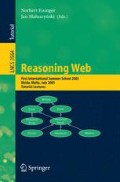Abstract
Applications using semantic technology are not fundamentally different from other software products. As standard applications, they need a well-defined development process, an appropriate modelling technology, and, to decrease construction cost, a good reuse technology for models and components. This paper shows that employing ontologies can help to enlarge the reuse factor. Ontologies improve the refinement process in object-oriented software development, simplify design of product lines, improve interoperability in component-based systems, and help in service-based applications, such as web services. Hence, ontologies will play an important role in the future engineering of software products.
Access this chapter
Tax calculation will be finalised at checkout
Purchases are for personal use only
Preview
Unable to display preview. Download preview PDF.
References
Abowd, G., Allen, R., Garlan, D.: Using Style to Understand Descriptions of Software Architecture. In: Proceedings of the ACM SIGSOFT 1993 Symposium on the Foundations of Software Engineering, pp. 9–20 (December 1993)
Aßmann, U.: Composing frameworks and components for families of semantic web applications. In: Bry, F., Henze, N., Małuszyński, J. (eds.) PPSWR 2003. LNCS, vol. 2901, pp. 1–15. Springer, Heidelberg (2003)
Aßmann, U.: Invasive Software Composition. Springer-Verlag, Heidelberg (2003)
Aßmann, U.: Architectural styles for active documents. Special Edition Software Composition Science of Computer Programming. Elsevier, Amsterdam (2005)
Batory, D., Cardone, R., Smaragdakis, Y.: Object-oriented frameworks and product lines. In: Donohoe, P. (ed.) Proceedings of the First Software Product Line Conference, pp. 227–247 (August 2000)
Bry, F., alia: Rules in a Semantic Web Environment (REWERSE). EU Project 6th framework. IST-2004-506779, http://www.rewerse.net
Bäumer, D., Gryczan, G., Knoll, R., Lilienthal, C., Riehle, D., Züllighoven, H.: Framework development for large systems. Communications of the ACM 40(10), 52–59 (1997)
Christensen, E., Curbera, F., Meredith, G., Weerawarana, S.: Web service description language (WSDL) language definition. Technical report, W3C (2001), http://www.w3.org/TR/wsdl
Czarnecki, K., Eisenecker, U.: Generative Programming: Methods, Techniques, and Applications. Addison-Wesley, Reading (2000)
Endres, A., Rombach, D.: A Handbook of software and systems engineering - Empirical observations, laws and theories. Addison-Wesley, Reading (2003)
JavaSoft. Enterprise Java Beans (TM), Version 2.0 (April 2000)
Löwy, J.: COM and.NET. O’Reilly, Sebastopol (2001)
Mili, R., Mili, A., Mittermeir, R.T.: Storing and retrieving software components: A refinement based system. IEEE Transactions on Software Engineering 23(7), 445–460 (1997)
Prieto-Dáz, R., Freeman, P.: Classifying software for reuse. IEEE Software 4(1), 6–16 (1987)
Priss, U.: Faceted knowledge representation. Electronic Transactions on Artificial Intelligence 4, 21–33 (2000)
Ranganathan, S.R.: Elements of Library Classification. Asia Publishing House, Bombay (1962)
Rumbaugh, J., Jacobson, I., Booch, G.: The Unified Modeling Language Reference Manual. Addison-Wesley, Reading (1999)
Siegel, J.: OMG overview: CORBA and the OMA in enterprise computing. Communications of the ACM 41(10), 37–43 (1998)
John, F.: Knowledge Representation: Logical, Philosophical, and Computational Foundations. Brooks Cole Publishing Co., Pacific Grove (2000)
Author information
Authors and Affiliations
Editor information
Editors and Affiliations
Rights and permissions
Copyright information
© 2005 Springer-Verlag Berlin Heidelberg
About this chapter
Cite this chapter
Aßmann, U. (2005). Reuse in Semantic Applications. In: Eisinger, N., Małuszyński, J. (eds) Reasoning Web. Lecture Notes in Computer Science, vol 3564. Springer, Berlin, Heidelberg. https://doi.org/10.1007/11526988_9
Download citation
DOI: https://doi.org/10.1007/11526988_9
Publisher Name: Springer, Berlin, Heidelberg
Print ISBN: 978-3-540-27828-3
Online ISBN: 978-3-540-31675-6
eBook Packages: Computer ScienceComputer Science (R0)

